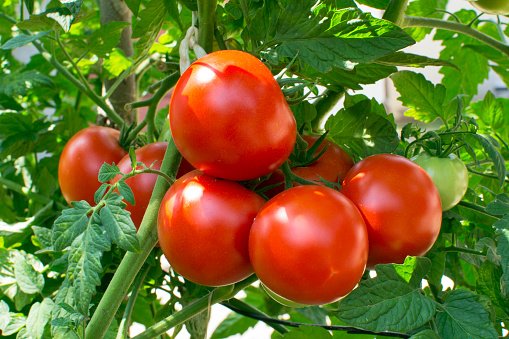Introduction.
Tomatoes are one of the most popular and widely consumed vegetables in Nigeria. From stews and soups to salads, no Nigerian kitchen is complete without tomatoes.
So, if you’ve been thinking about starting an agriculture business, a tomato farm could be a profitable and rewarding venture. But how do you even begin?
Starting a tomato farm in Nigeria isn’t just about planting seeds and waiting for them to grow. It’s a business that requires proper planning, knowledge, and strategy.
There’s a lot to consider – from choosing the right land, selecting the best tomato varieties, and managing pests and diseases, to understanding market demand.
But don’t worry, I’ve got you covered! In this article, I’ll walk you through everything you need to know about starting a tomato farm business in Nigeria.
Why Start a Tomato Farm?
Tomatoes are a staple in Nigerian cuisine, and the demand for them is huge. It’s one of the most consumed crops in the country, which makes it a reliable choice for anyone looking to get into farming.
Nigeria is one of the largest producers of tomatoes in Africa, yet the country still faces a shortfall due to issues like poor infrastructure, pests, and diseases. This gap in production creates a great opportunity for farmers.
Starting a tomato farm not only gives you the chance to tap into the huge local market, but it also allows you to supply fresh tomatoes to local markets, and restaurants, and even process them into sauces and pastes. It’s a versatile crop that can open doors to different business avenues.
How Do I Start a Tomato Farm Business in Nigeria?
1. Research the Tomato Farming Industry
Before you dive into the business, it’s crucial to do your homework. Learn as much as you can about tomato farming in Nigeria.
The good news is that tomatoes are grown all over the country, so there’s a wealth of information available to help you succeed. You’ll need to understand things like:
- Best farming practices
- Tomato varieties that grow well in different regions
- Common diseases and pests that affect tomatoes
- Where to sell tomatoes
- Seasonal factors that affect growth
Do some research about the region you want to farm in. Some areas in Nigeria have better conditions for tomatoes, so pick a location where the soil and climate are favorable.
2. Choose the Right Land
Location is key. You want to pick land that is fertile, has good drainage, and gets enough sunlight. Tomato plants need at least 6 hours of sunlight daily to grow well.
Avoid areas that are prone to flooding or have poor soil quality. If you’re not sure about the soil, you can conduct a soil test to check its pH level and fertility.
Also, ensure that the land is easily accessible for transporting your tomatoes to market. Proximity to major roads and markets can save you a lot of hassle when it’s time to sell your crops.
3. Prepare Your Farm
Land preparation is one of the most important steps in tomato farming. The soil needs to be well-prepared to support the growth of your plants.
This involves clearing the land, plowing, and adding organic matter (like compost) to improve the soil quality.
Tomatoes require good soil structure, so you might need to till the land and add fertilizers if needed. Make sure to follow the right planting techniques and spacing to allow your plants to grow freely. Crowding plants too closely can lead to diseases and poor fruit production.
4. Choose the Right Tomato Variety
There are several varieties of tomatoes grown in Nigeria. Some varieties do better in certain regions than others, so it’s important to choose wisely. Popular varieties in Nigeria include:
- Roma: Ideal for processing into sauces and pastes.
- Tigernut: A hybrid variety that is resistant to diseases.
- Olomowewe: A Nigerian variety that is popular for its sweet taste.
Depending on whether you plan to sell fresh tomatoes or process them, you might want to choose a variety that suits your market. If you’re aiming for fresh market sales, consider varieties that are firm and have good shelf life.
5. Planting and Crop Management
Tomatoes are typically grown from seeds or seedlings. You can either buy seedlings from a reputable nursery or grow your own from seeds.
Planting tomatoes involves sowing seeds in nurseries and later transplanting them when the seedlings are strong enough to withstand the elements.
Tomato plants need plenty of water, but it’s important not to overwater them as this can lead to root rot.
Drip irrigation is often recommended for tomatoes because it delivers water directly to the roots, minimizing water waste and reducing the chances of fungal diseases.
You’ll also need to manage pests and diseases. Some common issues with tomatoes include:
- Tuta absoluta (tomato leaf miner): This pest can damage the leaves, affecting growth.
- Blight: A fungal disease that causes black spots on the leaves and fruits.
Regularly inspect your farm for signs of disease or pest infestation and apply appropriate treatments if necessary. Always be cautious about the chemicals you use, especially if you plan to sell the tomatoes for consumption.
6. Harvesting and Post-Harvest Management
Tomatoes are ready to harvest when they turn red and firm. However, timing is important because overripe tomatoes may spoil quickly, while under-ripe tomatoes might not sell well. Harvest early in the morning or late in the evening to avoid heat stress on the fruits.
Post-harvest management is crucial. You need to handle the tomatoes carefully to avoid bruising and spoilage.
Ensure they are stored in a cool place to prolong freshness, and consider packaging them properly for transport to market.
7. Marketing and Sales
Selling your tomatoes is the final step in your farming journey. Tomatoes are in high demand, but there’s often competition. It’s important to have a clear marketing strategy to stand out. Consider selling directly to:
- Local markets
- Supermarkets
- Restaurants
- Tomato processing plants
If you have the resources, you can also explore value-added products like tomato paste or sauces, which could increase your profits.
8. Managing Finances
Like any business, keeping track of your finances is important. Budget for everything – from seeds, fertilizers, labor, and equipment, to marketing and transportation. Keep an eye on your revenue and expenses, and aim for profitability by continually improving your processes and increasing efficiency.
9. Scaling Up
Once you’ve established your farm and start making a profit, you can think about scaling up. You could expand your farm size, add more workers, or even start processing tomatoes into products like paste and sauces to add more value to your produce.
Scaling up requires planning, investment, and time, but it can help increase your earnings and make your farm business more sustainable in the long run.
FAQs
Q: How much capital do I need to start a tomato farm in Nigeria?
A: The amount of capital required depends on the size of the farm you want to start. A small-scale farm could cost anywhere between ₦150,000 to ₦500,000, but larger commercial farms could require more significant investment. It’s a good idea to start small and grow as you gain experience.
Q: When is the best time to plant tomatoes in Nigeria?
A: Tomatoes can be grown all year round in Nigeria, but the best time to plant them is during the dry season (November to March) when the weather is favorable. This helps avoid diseases that thrive in the wet season.
Q: How long does it take for tomatoes to mature?
A: Tomatoes typically take 60 to 90 days from planting to harvest, depending on the variety and growing conditions.
Conclusion
Starting a tomato farm in Nigeria can be a rewarding venture, but it requires effort, research, and smart planning.
The demand for tomatoes is high, and with the right approach, you can build a profitable business.
If you take the time to learn about the industry, choose the right land, and implement good farming practices, you can turn your tomato farm into a successful business.
Have you thought about the next step in growing your tomato farm business, or are you ready to dive in and start planting today?





GIPHY App Key not set. Please check settings